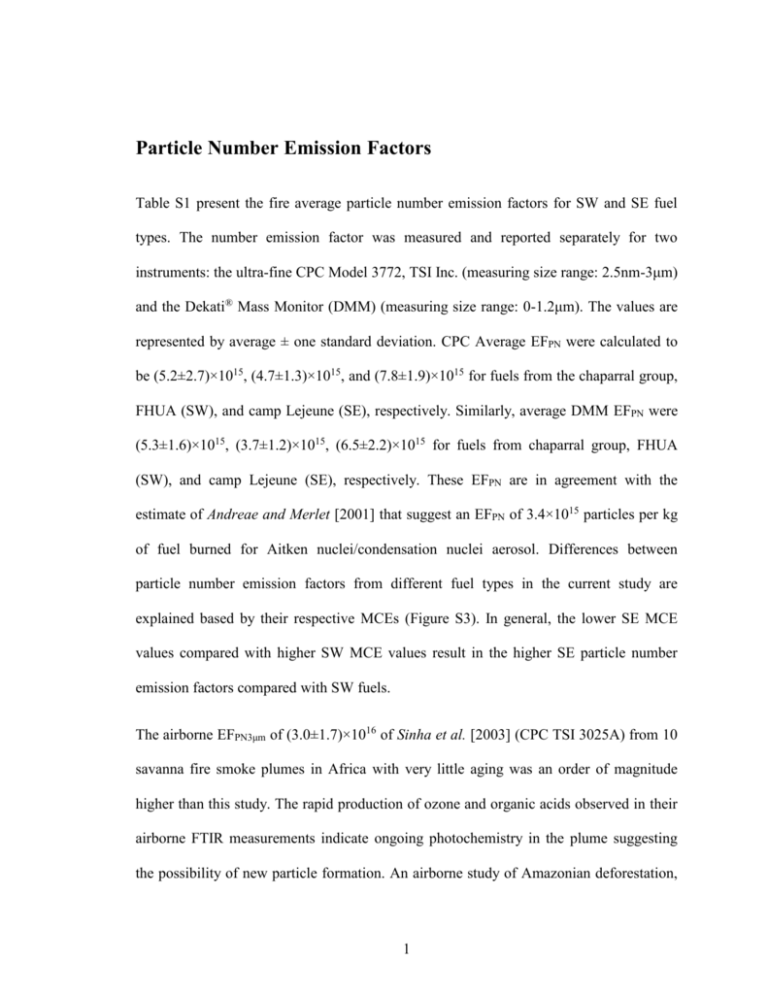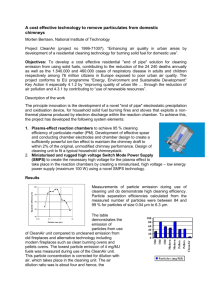18904rrauxtext s1
advertisement

Particle Number Emission Factors Table S1 present the fire average particle number emission factors for SW and SE fuel types. The number emission factor was measured and reported separately for two instruments: the ultra-fine CPC Model 3772, TSI Inc. (measuring size range: 2.5nm-3μm) and the Dekati® Mass Monitor (DMM) (measuring size range: 0-1.2μm). The values are represented by average ± one standard deviation. CPC Average EFPN were calculated to be (5.2±2.7)×1015, (4.7±1.3)×1015, and (7.8±1.9)×1015 for fuels from the chaparral group, FHUA (SW), and camp Lejeune (SE), respectively. Similarly, average DMM EFPN were (5.3±1.6)×1015, (3.7±1.2)×1015, (6.5±2.2)×1015 for fuels from chaparral group, FHUA (SW), and camp Lejeune (SE), respectively. These EFPN are in agreement with the estimate of Andreae and Merlet [2001] that suggest an EFPN of 3.4×1015 particles per kg of fuel burned for Aitken nuclei/condensation nuclei aerosol. Differences between particle number emission factors from different fuel types in the current study are explained based by their respective MCEs (Figure S3). In general, the lower SE MCE values compared with higher SW MCE values result in the higher SE particle number emission factors compared with SW fuels. The airborne EFPN3μm of (3.0±1.7)×1016 of Sinha et al. [2003] (CPC TSI 3025A) from 10 savanna fire smoke plumes in Africa with very little aging was an order of magnitude higher than this study. The rapid production of ozone and organic acids observed in their airborne FTIR measurements indicate ongoing photochemistry in the plume suggesting the possibility of new particle formation. An airborne study of Amazonian deforestation, 1 Guyon et al. [2005], measured an EFPN3μm of 4.6×1014-1.1×1016 particles/kg fuel burned covering the wide range of lab and field study values. Figure S4 presents the EFPN by the CPC versus the EFPN by the DMM. As shown, there is a relatively large coefficient of variation (with r2=0.63) in comparing the CPC and DMM. The overall particle number emission factor of CPC is observed to be about 82% of the DMM. It is noted that the DMM requires a robust size distribution to accurately invert the electronic signals to number concentrations [Mamakos et al., 2006] leading to greater variability in number count and possible biases in absolute number concentrations. Varying PN size distributions as combustion phase migrates from flaming to smoldering coupled with the different particle size ranges of the two instruments gave rise to the discrepancy--most burns produced strongly unimodal size distribution during flaming and bimodal during smoldering [Hosseini et al., 2010] (the ultrafine CPC 3776 has a particle size lower detection limit of 2.5 nm and the DMM has a size range of “0” to 1.2 µm). Similar to the observed dependency of PM mass on MCE, the linear correlation of EFPN of CPC and DMM with MCE is obtained (Figure S3). As shown, MCE and EFPN are weakly anti-correlated (rCPC2=0.27, rDMM2=0.33) which shows some natural variability and may reflect the wide range of fuel types of this study. The regression lines in this study are comparable to previous field studies. The airborne study of Guyon et al. [2005] who observed biomass burning of Amazonian forests reported a regression line of EFPN=(-2.80×MCE+2.76)×1016 that is 37% of the EFPN observed in this study. The Janhall et al. [2010] review paper, based on airborne measurements of biomass burning 2 of three fuel types (forest, savanna, and grass), estimates a regression line of EFPN=(3.46× MCE+3.44)×1016, about half the EFPN measured in the current study. These differences are easily attributed to coagulation losses of nucleation mode particles on short time scales [Reid et al., 1998; Akagi et al., 2012; Reid et al., 2005]. Moreover, the regression line calculated by Janhall et al. [2010] uses data points acquired from a Passive Cavity Aerosol Spectrometer Probe (PCASP), which has a lower cut-size of 100nm compared to the cut-size of 2.5 nm in the current study. 3 References Akagi, S. K., Craven, J. S., Taylor, J. W., McMeeking, G. R., Yokelson, R. J., Burling, I. R., Urbanski, S. P., Wold, C. E., Seinfeld, J. H., Coe, H., Alvarado, M. J., and Weise, D. R.(2012), Evolution of trace gases and particles emitted by a chaparral fire in California, Atmos. Chem. Phys., 12, 1397-1421, doi:10.5194/acp-12-1397-2012. Andreae, M., Merlet, P. (2001), Emission of trace gases and aerosols from biomass burning. Global Biogeochemical Cycles, 15(4), 955–966. Christian, T. J., B. Kleiss, R. J. Yokelson, R. Holzinger, P. J. Crutzen, W. M. Hao, T. Shirai, and D. R. Blake (2004), Comprehensive laboratory measurements of biomassburning emissions: 2. First intercomparison of open-path FTIR, PTR-MS, and GCMS/FID/ECD, J. Geophys. Res., 109, D02311, doi:10.1029/2003JD003874. Guyon, P., Frank, G., Welling, M., Chand, D., Artaxo, P., Rizzo, L., Nishioka, G., Kolle, O., Fritsch, H., Silva Dias, M. A. F., Gatti, L. V., Cordova, M., and Andreae, M. O. (2005), Airborne measurements of trace gas and aerosol particle emissions from biomass burning in Amazonia, Atmos. Chem. Phys. Discuss., 5, 2791-2831, doi:10.5194/acpd-52791-2005. Hosseini, S., Li, Q., Cocker, D., Weise, D., Miller, A., Shrivastava, M., Miller, J., Mahalingam, S., Princevac, M., & Jung, H. (2010), Particle size distributions from laboratory-scale biomass fires using fast response instruments. Atmos. Chem. Phys, 10, 8065–8076. Janhäll, S., Andreae, M. O., & Pöschl, U. (2010). Biomass burning aerosol emissions from vegetation fires: particle number and mass emission factors and size distributions. Atmos. Chem. Phys, 10(3), 1427-1439. Mamakos, A., Ntziachristos, L., Samaras, Z. (2006). Evaluation of the Dekati mass monitor for the measurement of exhaust particle mass emissions. Environmental science and technology, 40(15), 4739-4745. Reid, J. S., Hobbs, P. V., Ferek, R. J., Blake, D. R., Martins, J. V., Dunlap, M. R., and Liousse, C. (1998), Physical, chemical, and optical properties of regional hazes dominated by smoke in brazil, Journal of Geophysical Research, 103, 32059-32032. Reid, J., Koppmann, R., Eck, T., & Eleuterio, D. (2005), A review of biomass burning emissions part ii: intensive physical properties of biomass burning particles. Atmos. Chem. Phys, 5(3), 799–825. Sinha, P., Hobbs, P., Yokelson, R., Bertschi, I., Blake, D., Simpson, I., Gao, S., Kirchstetter, T., & Novakov, T. (2003), Emissions of trace gases and particles from savanna fires in Southern Africa. Journal of Geophysical Research, 108(D13), 8487. 4 Table S1 Weighted average PM number emission factors for the southwest and southeast fuels measured by CPC and Dekati Mass Monitor (DMM). Species/group CPC (#/kg)×1015 DMM (#/kg)×1015 Southwest cea 10.5 ± 6.7 8.1 ± 6.3 chs 5.1 4.8 cas 4.4 ± 0.9 3.9 ± 0.8 cos 3.2 ± 0.2 3.8 ± 0.1 man 4.3 ± 2.0 6.0 ± 3.9 mch 3.6 ± 0.1 4.9 ± 0.3 5.2 ± 2.7 5.3 ± 1.6 6.1 ± 1.5 5.1 ± 2.0 oas 3.9 ± 0.7 3.5 ± 0.6 oaw 4.0 ± 0.9 2.6 ± 0.3 4.7 ± 1.3 3.7 ± 1.2 lit 6.3 ± 2.1 3.3 ± 1.0 1yr 8.5 7.2 2yr 10.9 ± 1.3 9.7 ± 3.5 poc 6.7 ± 2.3 6.8 ± 2.8 cuh 7.0 ± 1.3 4.3 ± 2.8 uh 6.2 ± 1.8 4.6 ± 0.1 Camp Lejeune ave. 7.8 ± 1.9 6.5 ± 2.2 Chaparral ave. mes FHUA ave. Southeast 5 Figure S1. Schematic drawing of combustion laboratory, USDA’s forest service fire sciences laboratory, Missoula, MT. Detailed characteristics of the facility are explained in Christian et al. [2004]. 6 Figure S2. Size-resolved mass emission factors obtained through the MOUDI/filter setup (a)-(f); in sub-figure (g) the mass emission factors of PM3.5 from the six sampled MOUDIs are graphed versus their corresponding mass emission factors acquired from the filter measurements 7 Figure S3. Particle number emission factors −EFPN (#/kg fuel burned) vs. Modified Combustion Efficiency (MCE) for all southwestern and southeastern fuel types acquired by two different working principal instruments, butanol-based CPC (solid dark gray circles) and particle-charge based DMM (solid light gray circles) are shown here. The best linear fit also is depicted using the dashed lines. Figure S4. This graph illustrates the difference between measured particle number emission factors of butanol-based CPC and DMM; the slope is 0.82 and as shown DMM gives ~20% higher EFPN 8






